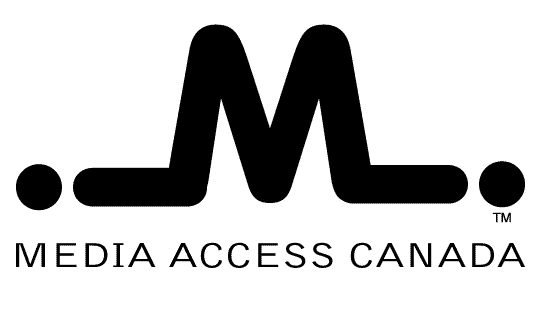On this page:
Events
August 26-31, 2012
- MAC/Access2020 represents Canada at JTC1/ISC/SC 35 Standards Conference in Paris
July 27, 2012
- MAC/Access2020 tours/briefs the Abilities Centre - Whitby
March 2, 2012
- MAC/Access2020 at CSUN, 2012 San Diego California
November 5, 2011
- ATIA 2011 Chicago Conference
Session P2P-13 - Status of Accessibility in Canadian Television
Chicago, Illinois, USA
October 22, 2011
- CNIB Conference: Perspectives 2011
Session 406 - Accessible Content in Canadian Broadcasting
Toronto, Ontario, CANADA
October 4, 2011
- Presentation at International Institute of Communications (IIC) Annual Conference
Johannesburg, South Africa
Week of September 19, 2011
- MAC will be in Ottawa the week of September 19th meeting with various Members of Parliament.
September 8, 2011
Papers
CSUN — March 2010
A business case for accessible content
Systemic inclusion of accessible media as part of the creative within the television and film production process is just the beginning of creating new revenues for content owners. As we move to the digital universe and examine alternative markets for accessible content, we can demonstrate new opportunities, a burgeoning industry and a reason to provide a 100% accessible content broadcast day for reasons that go beyond what policy makers have mandated for the provision of access to people with disabilities.
We now know the majority of closed captioning users are hearing — sports bars, out door television billboards, exercise gyms, and ESL students, to name a few. We know that bike riders and people with strollers believe curb cuts were installed for their convenience; and it is simply a convenience to turn on my computer screen magnifier, so that I might better see that image in the background of a picture. The provision of accessibility has always been a challenge until the greater population embraces it as their own. This will be the case for accessible content in a digital universe if the key issues for the provision of accessibility are addressed.
Key influencers in the successful execution of multi-purpose and multi-platform accessible content are avoidance of retrofit in the upcoming NTSC 2.0 standard, policy initiatives at the regulatory and legislative levels; open de facto standards and best practice guides for accessible content; compliance tools; social marketing; and, research and development.
A recent international inter-juristictional research initiative sourcing policy, standards and technological innovation for accessible content indicates Canada is a leader in providing an ACCESSIBILITY LENS leading to tangible results with the key influencers. These influencers have an ACCESSIBILITY LENS
leading to tangible results with the key influencers. These influencers have an ACCESSIBILITY LENS that are beginning to impact new revenues for accessible content and, as such are enjoying international recognition. At the Canadian federal government level, Industry Canada continues to vet its policy initiatives through its Minister's Advisory Committee on Accessible Devices; the Communication Research Centre participates in the NTSC 2.0, with an ACCESSIBILITY LENS
that are beginning to impact new revenues for accessible content and, as such are enjoying international recognition. At the Canadian federal government level, Industry Canada continues to vet its policy initiatives through its Minister's Advisory Committee on Accessible Devices; the Communication Research Centre participates in the NTSC 2.0, with an ACCESSIBILITY LENS and the Department of Canadian Heritage is championing the development of industry standards for Descriptive Video, while the Canadian Radio-Television and Telecommunications Commission (Canada's equivalent to the FCC) has mandated the updating and industry compliance of Closed Captioning standards.
and the Department of Canadian Heritage is championing the development of industry standards for Descriptive Video, while the Canadian Radio-Television and Telecommunications Commission (Canada's equivalent to the FCC) has mandated the updating and industry compliance of Closed Captioning standards.
In broadcasting CTVglobemedia, a Canadian national broadcaster, has sponsored MEDIAC INC. to do empirical research into mandate vs. compliance that will lead to the development of compliance measurement tools and DTV radio is now being considered just one of many innovative programming opportunities to simulcast descriptions. Downloading captions and descriptions to Ipods is one of the many solution based concepts that address not only access, but the ability to access at different times and through media that works best for the user.
So what else do we have to do? A national digital strategy for accessibility that considers policy such as Broadcasting-IP Synchronization standards; Copyright policy which provides clear direction on ownership and rights; post secondary curriculum for the production of accessible content and the elimination of not-for-profit organizations, so that an emerging competitive and private sector industry can compete in a level playing field.
An emerging opportunity for the demand of accessible content for a national and international audience will occur as the Canadian business plan for accessible content is further developed and implemented. Its systemic policy and other initiatives will result in a level of quality and consistency the will allow for multi-platform distribution. With a national digital strategy with an ACCESSIBILITY LENS , to amalgamate the pioneering work being done across the country, Canada will continue to profit from its pioneering work in all of the key stakeholder industries that will ultimately benefit from new revenues in a digital world.
, to amalgamate the pioneering work being done across the country, Canada will continue to profit from its pioneering work in all of the key stakeholder industries that will ultimately benefit from new revenues in a digital world.

 Events and Papers
Events and Papers